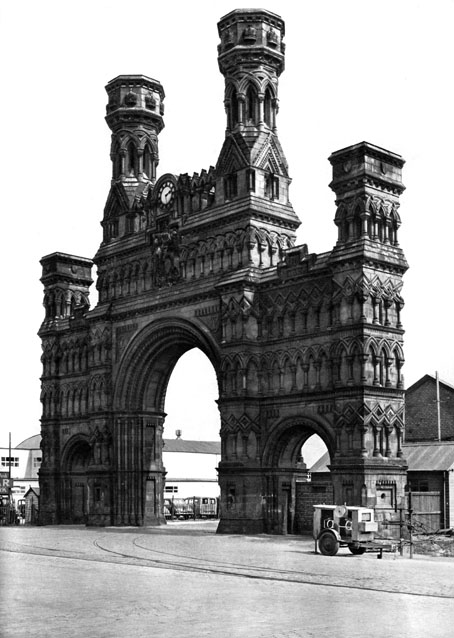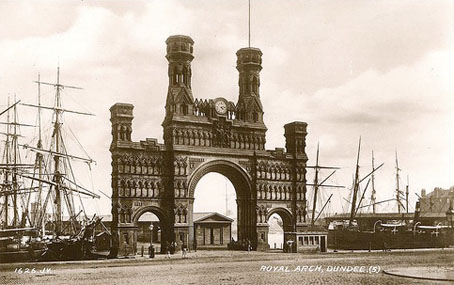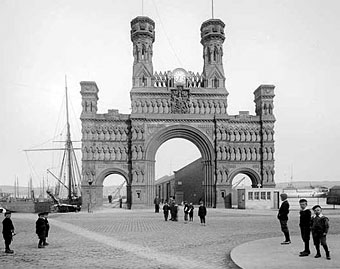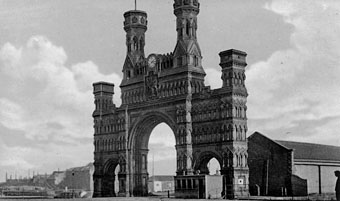
The Royal Arch, Dundee, photographed by Edwin Smith.
It’s an odd thing to discover that a structure you’ve known about for years has been demolished for almost as long as you’ve been alive. It took a review of Britain’s Lost Cities by Gavin Stamp to inform me that the curious Royal Arch in Dundee, Scotland, built between 1849 and 1853, was no more. I only knew it from this photograph in an old Thames & Hudson book, Scotland (1955) by Edwin Smith and GS Fraser.

Even though the arch had an official function—providing a ceremonial gateway for Queen Victoria—in its free-standing singularity and historical confection it’s not very far removed from the numerous follies that still litter the British countryside. Being a long-time fan of the pointless architectural confection, I like to know that these things are still around even if they’re not so good to look at; they make the world a more interesting place.

The architect of this pastiche, which looks like a chunk of Norman cathedral dumped on the dockside, was one John Thomas Rochead whose oddly-shaped and frequently spectacular Wallace Monument still stands. I think it’s the incongruity I like about the arch, its setting and style are completely at odds and it has the fake ruin aspect of many follies, looking like a fragment of something larger. Monuments are often a sub-class of folly and Scotland has another fine example with the Scott Monument in Edinburgh.

Rochead’s arch was demolished in 1964 to make way for the Tay Road Bridge, another victim of the Sixties’ purge of Victorian eccentricity. I don’t always disagree with those purges, the Victorians had no qualms about demolishing older buildings and some of the structures whose demolition Gavin Stamp complains about were pretty awful. Euston Station in London is a soulless glass barn but I can’t see how its exterior would be improved if the heavy and dull Euston Arch had been allowed to remain as its gateway. What we’re seeing today is a reaction to that reaction, with the concrete buildings that were raised on the rubble of their Victorian forebears suffering their own waves of demolition. What goes around, comes around, and even the most apparently permanent structure can be swept away when attitudes change.
Previously on { feuilleton }
• Lenin Rising
• Dead Monuments
• The Triangular Lodge
• Pyramid mausoleum

The Wallace monument appeals to me in a very dramatic way, at least it appears dramatic from the view provided in the link, the Royal Arch, on the other hand appeals to me because it looks ludicrous, as you say the object and the environment are at odds. It looks like a site that would strike Terry Gilliam’s fancy, or someone like him, if only it were still around.
If you Google the Wallace monument (or look on Flickr) you’ll find some great pictures of it, it suits its gorgeous surroundings.
There’s a book called “Lost Chicago” with photographs of countless old buildings and mansions—veritable palaces—that are long gone. Sigh…
I’ve got a similar book called Lost Europe. There’s a lot that was lost there since so many cities were bombed during WW2.
Unfortunately—or fortunately!—Chicago has no such excuse for demolishing architectural treasures. It all boils down to the greed that goes hand-in-hand with capitalism.
Hi Eroom,
I actually posted something about snow sculpting before Xmas. I think the annual ice sculpture festival held in the same place is running at the moment.
I suppose the most ephemeral sort of buildings would have to be ice sculptures or sand sculptures
http://www.dmoz.org//Arts/Visual_Arts/Sculpture/Sculptors/Sand_and_Ice//
http://en.wikipedia.org/wiki/Ice_sculpture
http://en.wikipedia.org/wiki/Sand_sculptures
From a cosmic perspective everything is ephemeral even the universe I suppose
http://en.wikipedia.org/wiki/Heat_death_of_the_universe